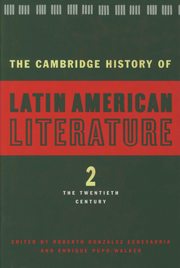Book contents
- Frontmatter
- Introduction to Volume 2
- 1 Modernist poetry
- 2 Modernist prose
- 3 The Vanguardia and its implications
- 4 The literature of Indigenismo
- 5 Afro-Hispanic American literature
- 6 The Criollista novel
- 7 The novel of the Mexican Revolution
- 8 The Spanish American novel from 1950 to 1975
- 9 The Spanish American novel: recent developments, 1975 to 1990
- 10 Spanish American poetry from 1922 to 1975
- 11 The modern essay in Spanish America
- 12 Literary criticism in Spanish America
- 13 The autobiographical narrative
- 14 The twentieth-century short story in Spanish America
- 15 Spanish American theatre in the twentieth century
- 16 Latin American (Hispanic Caribbean) literature written in the United States
- 17 Chicano literature
- Index
- Bibliographies
Introduction to Volume 2
Published online by Cambridge University Press: 28 March 2008
- Frontmatter
- Introduction to Volume 2
- 1 Modernist poetry
- 2 Modernist prose
- 3 The Vanguardia and its implications
- 4 The literature of Indigenismo
- 5 Afro-Hispanic American literature
- 6 The Criollista novel
- 7 The novel of the Mexican Revolution
- 8 The Spanish American novel from 1950 to 1975
- 9 The Spanish American novel: recent developments, 1975 to 1990
- 10 Spanish American poetry from 1922 to 1975
- 11 The modern essay in Spanish America
- 12 Literary criticism in Spanish America
- 13 The autobiographical narrative
- 14 The twentieth-century short story in Spanish America
- 15 Spanish American theatre in the twentieth century
- 16 Latin American (Hispanic Caribbean) literature written in the United States
- 17 Chicano literature
- Index
- Bibliographies
Summary
Spanish American literature’s best-known works have appeared in the modern period; that is, from the late 1800s to the present. This volume of The Cambridge History of Latin American Literature, therefore, covers the best-known and most studied genres, authors, and works, from Rubén Darío’s Azul (1888), to Gabriel García Márquez’s Cien años de soledad (1967) [One Hundred Years of Solitude] including the likes of Mariano Azuela’s Los de abajo (1915) [The Underdogs], Rómulo Gallegos’s Doña Bárbara (1929) [Doña Barbara], Jorge Luis Borges’s Ficciones, Alejo Carpentier’s El reino de este mundo (1949) [The Kingdom of this World], César Vallejo’s Trilce (1922), Pablo Neruda’s Canto general (1950), and Octavio Paz’s Piedra de sol (1957) [Sunstone], to name only a few of the high peaks. As considerable attention has already been given to these works, the scholar will find in these chapters of the History the most extensive revisionism. At the same time, the general reader will find an introduction to the most dynamic and current areas of Latin American literature.
Whereas in the coverage of earlier periods mostly fresh research into the primary works was adduced, here the study of each work, author or period is accompanied by the consideration of a substantial body of criticism, not to mention an already established historical scheme. It is also in this volume that we reach that most elusive, yet most influential of periods: the present one, which is also, of course, our own. (Elusive because it is impossible to delimit it, influential because it is the moment from which we write.)
- Type
- Chapter
- Information
- Publisher: Cambridge University PressPrint publication year: 1996

